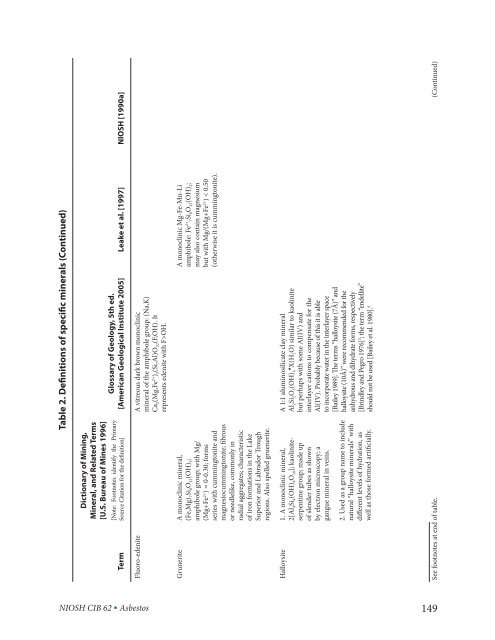Asbestos Fibers and Other Elongate Mineral Particles: State of the ...
Asbestos Fibers and Other Elongate Mineral Particles: State of the ...
Asbestos Fibers and Other Elongate Mineral Particles: State of the ...
- No tags were found...
Create successful ePaper yourself
Turn your PDF publications into a flip-book with our unique Google optimized e-Paper software.
Table 2. Definitions <strong>of</strong> specific minerals (Continued)<br />
Glossary <strong>of</strong> Geology, 5th ed.<br />
[American Geological Institute 2005] Leake et al. [1997] NIOSH [1990a]<br />
Dictionary <strong>of</strong> Mining,<br />
<strong>Mineral</strong>, <strong>and</strong> Related Terms<br />
[U.S. Bureau <strong>of</strong> Mines 1996]<br />
[Note: Footnotes identify <strong>the</strong> Primary<br />
Source Citation for <strong>the</strong> definition]<br />
Term<br />
Fluoro-edenite A vitreous dark brown monoclinic<br />
mineral <strong>of</strong> <strong>the</strong> amphibole group: (Na,K)<br />
Ca2(Mg,Fe2+ ) 5(Si7Al)O22(F,OH). It<br />
represents edenite with F>OH.<br />
NIOSH CIB 62 • <strong>Asbestos</strong><br />
A monoclinic Mg-Fe-Mn-Li<br />
amphibole: Fe2+ 7Si8O22(OH) 2;<br />
may also contain magnesium<br />
but with Mg/(Mg+Fe2+ ) < 0.50<br />
(o<strong>the</strong>rwise it is cummingtonite).<br />
Grunerite A monoclinic mineral,<br />
(Fe,Mg) 7Si8O22(OH) 2;<br />
amphibole group; with Mg/<br />
(Mg+Fe2+ ) = 0-0.30; forms<br />
series with cummingtonite <strong>and</strong><br />
magnesiocummingtonite; fibrous<br />
or needlelike, commonly in<br />
radial aggregates; characteristic<br />
<strong>of</strong> iron formations in <strong>the</strong> Lake<br />
Superior <strong>and</strong> Labrador Trough<br />
regions. Also spelled gruenerite.<br />
A 1:1 aluminosilicate clay mineral<br />
Al •<br />
2Si2O5(OH) 4 X(H2O) similar to kaolinite<br />
but perhaps with some Al(IV) <strong>and</strong><br />
interlayer cations to compensate for <strong>the</strong><br />
Al(IV). Probably because <strong>of</strong> this it is able<br />
to incorporate water in <strong>the</strong> interlayer space<br />
[Bailey 1989]. The terms “halloysite (7Å)” <strong>and</strong><br />
halloysite (10Å)” were recommended for <strong>the</strong><br />
anhydrous <strong>and</strong> dihydrate forms, respectively<br />
[Brindley <strong>and</strong> Pegro 1976] 3 ; <strong>the</strong> term “endellite”<br />
should not be used [Bailey et al. 1980]. 4<br />
Halloysite 1. A monoclinic mineral,<br />
2[Al4Si4(OH) 8O10]; kaoliniteserpentine<br />
group; made up<br />
<strong>of</strong> slender tubes as shown<br />
by electron microscopy; a<br />
gangue mineral in veins.<br />
2. Used as a group name to include<br />
natural “halloysite minerals” with<br />
different levels <strong>of</strong> hydration, as<br />
well as those formed artificially.<br />
See footnotes at end <strong>of</strong> table. (Continued)<br />
149

















